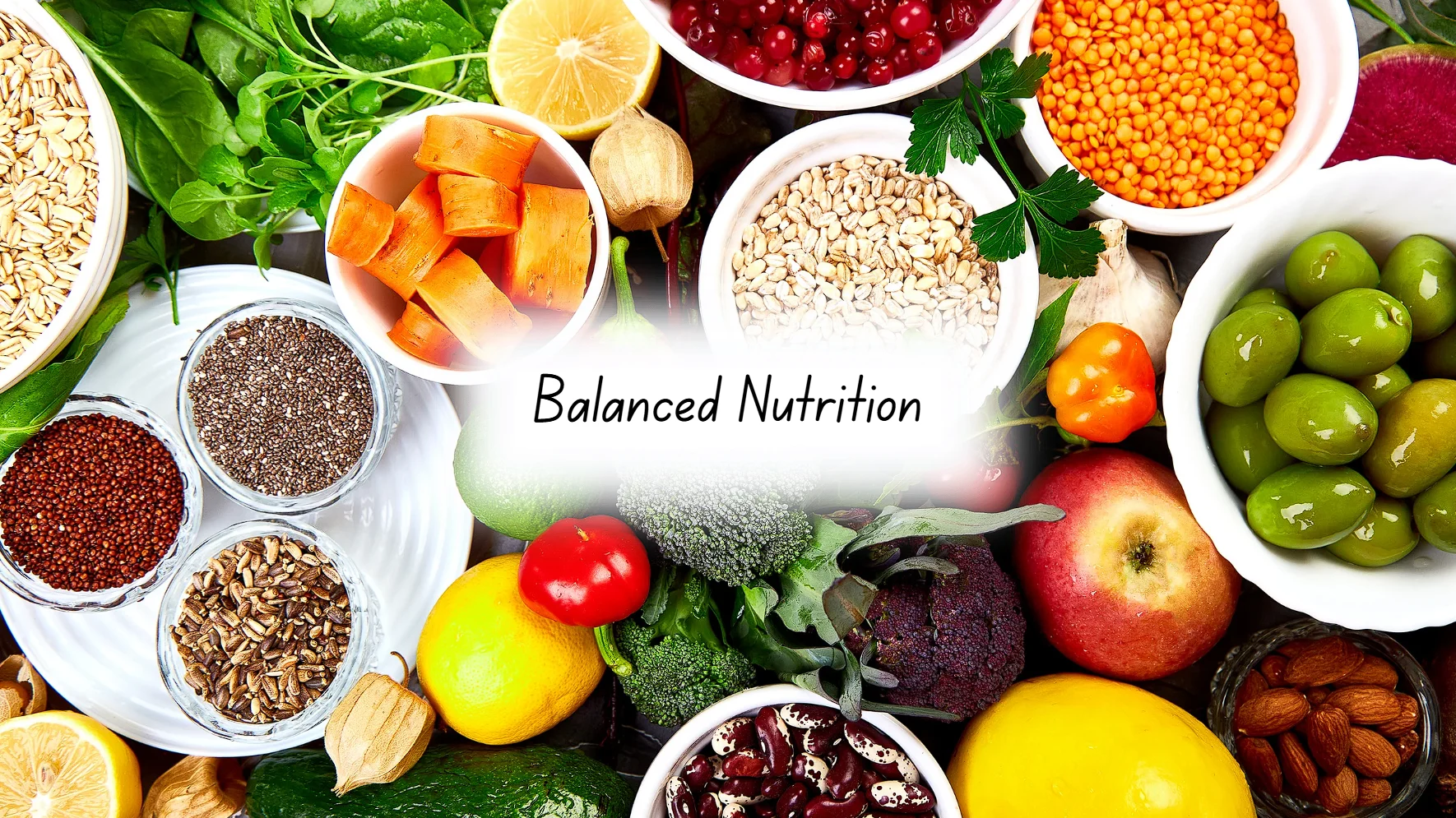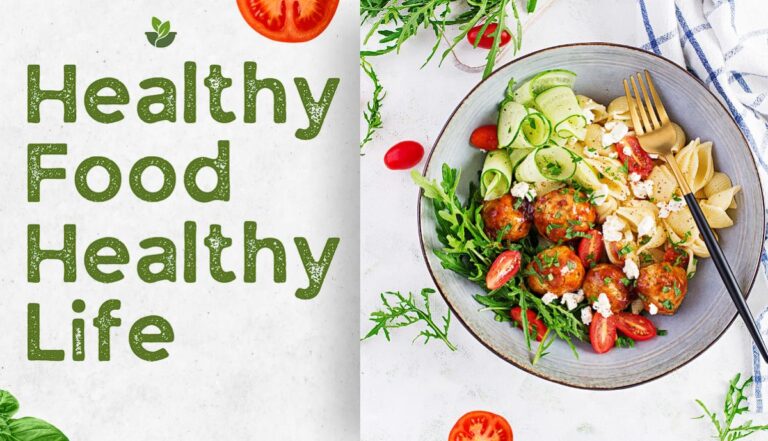Discover the Secrets of Balanced Nutrition: Essential Tips for Optimal Health

Introduction to Balanced Nutrition
Feeding Your Body the Right Way Have you ever wondered why some people seem to have boundless energy, a glowing complexion, and are rarely plagued by illness? The secret lies in their diet – specifically, their commitment to balanced nutrition.
It’s not just a buzzword, it’s a lifestyle that can revolutionize your well being. So, let’s delve into the world of balanced nutrition and unlock the secrets to a healthier, happier you!
Table of Contents
The Importance of Balanced Nutrition for Overall Health & Well being
Fueling Your Body’s Potential We live in a fast-paced world where convenience often takes priority over health. Grabbing a quick snack or ordering takeout may seem convenient, but it often comes at the expense of our bodies.
Balanced nutrition is essential because it provides our bodies with the necessary fuel and nutrients they need to function optimally. By following a balanced diet, we can boost our immune systems, ward off diseases such as diabetes and heart conditions, maintain a healthy weight, and improve mental clarity.
It doesn’t stop there! A well-balanced nutrition also enhances our mood and supports emotional well-being.
Imagine your body as an intricate machine: without the right fuel and maintenance, it won’t run smoothly. Similarly, without balanced nutrition, our bodies become susceptible to fatigue, sluggishness, nutritional deficiencies, and an array of health problems that hinder us from living life to its fullest potential.

The Definition of Balanced Nutrition
Striking the Perfect Balance What exactly does balanced nutrition mean? Simply put: it involves consuming all essential nutrients in appropriate quantities.
It’s about finding harmony between macronutrients (carbohydrates, proteins, and fats) and micronutrients (vitamins and minerals). Carbohydrates are the body’s primary source of energy.
Proteins help repair cells and tissues, while fats provide insulation and support hormone production. Vitamins and minerals play critical roles in regulating bodily functions, such as strengthening bones, boosting immunity, and aiding digestion.
A balanced nutrition consists of a variety of foods from all food groups. It includes lean protein sources like chicken or fish; whole grains such as brown rice or quinoa; colorful fruits and vegetables for vitamins and fiber; healthy fats from sources like avocados or nuts; and dairy or plant-based alternatives for calcium.
Remember, balance is key! Rather than fixating on eliminating entire food groups or following fad diets, focus on nourishing your body with a wide range of nutrients that it needs to thrive.
Carbohydrates: Fuel for the Body
Simple vs Complex Carbohydrates and their Impact on Blood Sugar Levels
Carbohydrates are the body’s primary source of energy, providing fuel for various bodily functions. They can be categorized into two main types: simple carbohydrates and complex carbohydrates.
Simple carbohydrates are made up of one or two sugar molecules, making them easier to break down and digest quickly. Common sources of simple carbohydrates include table sugar, fruit juices, sweets, and white bread.
On the other hand, complex carbohydrates are composed of long chains of sugar molecules that take longer to break down in the body. Foods like whole grains, legumes, vegetables, and oats fall under this category.
Due to their complex structure, these carbohydrates release glucose into the bloodstream at a slower pace compared to simple carbs. This slow release helps maintain stable blood sugar levels and provides sustained energy throughout the day.
Good Sources of Carbohydrates and Recommended Daily Intake
Incorporating a variety of nutritious carbohydrate sources into your diet is essential for maintaining optimal health. Whole grains such as quinoa, brown rice, whole wheat bread/pasta, and oats are excellent choices as they provide essential vitamins, minerals, fiber, and beneficial phytochemicals.
Fruits such as berries, apples, oranges along with vegetables like sweet potatoes and leafy greens also contribute to a healthy carbohydrate intake while offering additional nutrients. As for recommended daily intake of carbohydrates varies based on factors such as age group,
sex or level of physical activity , it is generally recommended that 45-65% of total daily calorie intake should come from carbs . For example , if you’re consuming 2000 calories per day , 900-1300 calories should be sourced from carbs which would equal approx 225 – 325 grams per day .
Proteins: The Body’s Repair Crew
Proteins play a crucial role in the growth, repair, and maintenance of body tissues. They are made up of smaller units called amino acids.
There are 20 different types of amino acids, out of which 9 are considered essential, meaning the body cannot produce them and must acquire them through diet. Essential amino acids are responsible for protein synthesis and aiding in various bodily functions.
Sources of complete proteins include animal products such as meat, poultry, fish, eggs, milk, and dairy products. These sources contain all nine essential amino acids in the right proportions.
Incomplete proteins can be found in plant-based foods such as legumes (beans and lentils), nuts, seeds, grains (quinoa and rice), and vegetables. While they may lack one or more essential amino acids individually, consuming a variety of plant-based proteins throughout the day can ensure you meet your daily requirements.

Fats: The Misunderstood Nutrient
Contrary to popular belief that fats should be avoided altogether, they play a vital role in maintaining good health. Fats provide energy and support cell growth while also helping absorb fat-soluble vitamins like A,D,E & K.
There are different types of fats—saturated fats mostly found in animal products like fatty cuts of meat or dairy , unsaturated fats found in plant based oils , nuts and seeds , avocados etc & trans fats that are often found in processed foods as it is created by adding hydrogen to liquid vegetable oils to make them more solid . While saturated fats should be consumed moderately as excessive intake may elevate cholesterol levels & increase risk for heart diseases , unsaturated fats such as monounsaturated & polyunsaturated fats have several health benefits .
Including sources like olive oil , avocados , nuts/seeds can help reduce bad LDL cholesterol levels & decrease risk for heart disease. It is important to limit the consumption of trans fats as they are associated with increased risk of heart disease and inflammation.
Checking food labels for ingredients such as “partially hydrogenated oils” is a good way to avoid trans fats. Incorporating healthy sources of fats into your diet is crucial for overall well-being, but it’s equally important to be mindful of portion sizes and moderation.
Vitamins: The Superheroes of Balanced Nutrition
Water-soluble vs fat-soluble vitamins and their functions in the body
When it comes to vitamins, they are like the superheroes of nutrition, swooping in to save our bodies from potential health villains. Vitamins are classified into two main types: water-soluble and fat-soluble.
Water-soluble vitamins include vitamin C and all the B-vitamins (such as thiamine, riboflavin, niacin, and folic acid), while fat-soluble vitamins encompass vitamins A, D, E, and K. Water-soluble vitamins have a unique quality – they dissolve in water.
This means that our bodies don’t store excess amounts of these vitamins; instead, we need a daily supply through food or supplements. These vital nutrients have various functions in our bodies.
For example, vitamin C acts as an antioxidant to protect cells from damage and supports collagen production for healthy skin. B-vitamins are essential for energy production by aiding in converting food into fuel.
On the other hand, fat-soluble vitamins dissolve in dietary fats and can be stored in our body’s fatty tissues for later use. They require dietary fats for proper absorption since they are not readily excreted through urine like water-soluble ones.
Vitamin A promotes healthy vision and immune function while vitamin D helps regulate calcium absorption for strong bones. Vitamin E acts as an antioxidant protecting cells from oxidation damage while vitamin K plays a crucial role in blood clotting.
Common vitamin deficiencies and food sources to overcome them
Vitamin deficiencies can occur when we don’t consume enough of certain nutrients through our diets or have difficulty absorbing them due to certain health conditions or medication use. Let’s take a look at some common deficiencies along with foods that can help overcome them: 1. Vitamin C deficiency: This deficiency can lead to scurvy, characterized by fatigue, bleeding gums, and weakened immune function.
To boost your vitamin C intake, include citrus fruits like oranges and strawberries in your diet, along with green leafy vegetables like broccoli and spinach. 2. Vitamin D deficiency: Insufficient sun exposure and limited dietary sources can contribute to a lack of vitamin D. This deficiency can lead to weakened bones (osteoporosis) and increased risk of certain diseases.
Foods rich in vitamin D include fatty fish like salmon and mackerel, fortified dairy products, egg yolks, and mushrooms. 3. Vitamin B12 deficiency: Common among vegetarians and vegans since this crucial vitamin is mainly found in animal-derived foods.
A B12 deficiency can cause anemia and neurological issues. Good sources for B12 are meat products such as beef liver or clams, poultry, fish like trout or salmon, dairy products (milk and yogurt), and eggs.
4. Vitamin A deficiency: Insufficient intake of vitamin A can result in poor vision at night (night blindness) and compromised immune function. Foods rich in this vitamin include carrots, sweet potatoes, spinach, kale, yellow fruits like mangoes or apricots.

Minerals: The Unsung Heroes
Minerals may not get as much attention as vitamins do but make no mistake – they are the unsung heroes that keep our bodies functioning optimally. These essential nutrients help maintain bodily functions ranging from building strong bones to regulating heartbeat rhythms.
There are two main categories of minerals – major minerals (those we need in larger quantities) and trace minerals (required in smaller amounts). Major minerals include calcium for bone health; magnesium for muscle function; potassium for maintaining fluid balance; sodium for nerve signaling; phosphorus for energy production; sulfur for protein synthesis; chloride for proper digestion; and finally iron which carries oxygen to our cells.
On the other hand, trace minerals are equally important, albeit needed in smaller quantities. Examples of trace minerals include zinc for immune function and wound healing; copper for red blood cell production; selenium for antioxidant defense; manganese for bone health and metabolism; chromium for glucose regulation; iodine for thyroid hormone production; fluorine for dental health, and molybdenum for enzyme activity.
Signs of mineral deficiencies and dietary sources to meet daily requirements
Mineral deficiencies can manifest in various ways depending on the specific nutrient lacking in our diet. Here are some common signs of mineral deficiencies along with dietary sources to help meet our daily requirements: 1. Calcium deficiency: Symptoms may include weakened bones (osteoporosis), muscle cramps, and tingling sensations.
Good sources of calcium include dairy products like milk, cheese, and yogurt, as well as leafy greens such as kale or broccoli. 2. Magnesium deficiency: This can result in muscle weakness, fatigue, and irregular heartbeat.
Foods rich in magnesium include nuts (particularly almonds), legumes (like black beans), whole grains (such as brown rice or quinoa), and dark chocolate. 3. Iron deficiency: Known as anemia, this condition can cause fatigue, pale skin, shortness of breath, and impaired cognitive function.
Excellent iron sources include lean meats like beef or chicken liver, beans (such as lentils or chickpeas), fortified cereals or breads. 4. Zinc deficiency: Signs may include hair loss, delayed wound healing, weakened immune system functioning.
Food sources rich in zinc consist of oysters, beef or lamb meat cuts like shank or chuck roast), poultry (chicken or turkey), legumes (such as chickpeas). Remember to consult with a healthcare professional if you suspect any mineral deficiencies since they can perform tests to accurately diagnose them and provide appropriate guidance regarding supplementation, if necessary.
Portion Control: Size Matters
Understanding serving sizes versus portion sizes
When it comes to maintaining a balanced nutrition plan, understanding the difference between serving sizes and portion sizes is crucial. A serving size refers to the recommended amount of food that one should consume, as determined by dietary guidelines. On the other hand, portion size refers to the actual amount of food that is consumed in one sitting.
It’s important to note that these two concepts are often not aligned, as portion sizes have been steadily increasing over the years. To better understand serving sizes, familiarize yourself with nutrition labels on food packaging.
They provide valuable information on recommended servings per container and nutritional content per serving. By paying attention to these labels, you can easily keep track of your intake and ensure you’re consuming appropriate amounts.

Tips for practicing portion control at home and when dining out
Practicing portion control can be challenging, especially when we’re surrounded by oversized plates and super-sized meal options. However, there are several strategies you can employ to help keep your portions in check. At home:
1. Use smaller plates: Opting for smaller plates tricks our minds into thinking we have a fuller plate than we actually do, leading us to feel satisfied with smaller portions. 2. Measure your food: Invest in measuring cups or a kitchen scale to accurately measure your ingredients before cooking or preparing meals.
3. Pre-portion snacks: Instead of munching from a large bag of chips or box of cookies while watching TV, divide them into individual snack bags or containers beforehand. When dining out:
1. Share dishes: Splitting an entrée with a friend or family member not only saves money but also helps control portion sizes. 2. Choose appetizers as mains: Many appetizers offer reasonable portions compared to main courses which are often larger than necessary.
3. Ask for a to-go box: If you’re served a larger portion than you can finish, don’t hesitate to ask for a take-out container. This way, you can enjoy the rest as a leftover meal.
Importance of mindful eating to prevent overeating
Mindful eating is an invaluable practice that encourages us to slow down & truly savor our food. By paying attention to our senses and being present during meals, we can better recognize our body’s hunger and fullness cues, which in turn helps prevent overeating. To incorporate mindful eating into your day to day routine:
1. Eat without distractions: Avoid eating in front of the TV or while scrolling through your phone. Focus on the flavors, textures, and aromas of your meal.
2. Chew slowly: Take your time with each bite and chew thoroughly before swallowing. This allows your brain to register satisfaction, reducing the likelihood of overeating.
3. Listen to your body: Pause midway through your meal to assess if you’re still hungry or satisfied. Only continue eating if you genuinely feel hungry.
By adopting mindful eating practices and being conscious of serving sizes versus portion sizes, you can develop healthier habits that lead to better portion control and overall balanced nutrition. Remember, it’s not about depriving yourself but rather finding a balance that supports both enjoyment and nourishment!
Balancing Your Plate: Creating a Healthy Meal
Building a balanced plate with macronutrients
Eating a well-balanced meal is crucial for maintaining optimal health. When it comes to creating a healthy plate, it’s essential to include the right balance of macronutrients.
These macronutrients, which consist of carbohydrates, proteins, and fats, provide the body with energy and support various bodily functions. To achieve an ideal balance on your plate, aim to fill half of it with colorful fruits and vegetables.
These nutrient-packed foods are rich in vitamins, minerals, and fiber that contribute to overall well-being. You can choose from a variety of options like leafy greens such as kale or spinach, vibrant bell peppers, crunchy carrots, or juicy berries.
Next up is protein – an essential component for muscle repair and growth. Adding a palm-sized portion of lean protein to your plate is recommended.
Options include skinless chicken breast, fish like salmon or tuna packed with omega-3 fatty acids, tofu for vegetarians/vegans, or legumes like lentils or chickpeas. Always remember to incorporate healthy fats into your meal.
These fats are vital for brain function and play a role in reducing inflammation in the body. Opt for sources such as avocados that provide monounsaturated fats or nuts like almonds or walnuts rich in omega-3 fatty acids.

Ideal
An ideal balanced nutrition plate should consist of approximately 50% fruits and vegetables (half the plate), 25% lean protein (a palm-sized portion), and 25% whole grains/starches (about a fist-sized portion). By following this template when preparing your meals throughout the day, you can ensure that you’re providing your body with the necessary nutrients it needs to thrive.
For instance, imagine having grilled chicken breast with a side of roasted sweet potatoes and steamed broccoli. You can also add a small handful of mixed nuts or sprinkle some flaxseeds on your salad for an extra dose of healthy fats.
This combination offers a well-rounded meal that contains all the macronutrients in the right proportions. Remember, it’s not just about what’s on your plate but also how much you consume.
Portion control is important to maintaining a healthy weight & preventing overeating. Pay attention to your body’s signals of hunger and fullness, and try to eat mindfully without distractions.
Conclusion
Creating a balanced nutrition plate with the right mix of macronutrients is fundamental for maintaining good health. By filling half your plate with fruits and vegetables, adding lean protein, and incorporating healthy fats, you’re ensuring that you provide your body with essential nutrients for energy production, muscle repair, brain function, and overall well-being. Building healthy eating habits doesn’t have to be complicated or restrictive; it can be an enjoyable journey towards optimal health.
So go ahead – experiment with new recipes, try out different fruits and vegetables, and explore various sources of lean proteins. Embrace the idea that every meal is an opportunity to nourish yourself in a way that promotes vitality and longevity.
By making conscious choices when constructing our plates, we empower ourselves to lead healthier lives. So let us embark on this nutrition adventure together – one balanced meal at a time!
Also See:
- 10 Mouthwatering High Protein Vegan Snacks: Boost Your Energy
- Unlocking the Enigmatic Realm of Guitar Price: Harmony and Haggling
- Soya ChipsCrispy Delight: Soya Chips – A Healthy and Tasty Snack
- Building a Strong Relationship Foundation: Key Elements & Tips
- The Most Played Mobile Game in the World: A Detailed Exploration
- Disruptive Technology: Unveiling the Transformative Power
- Pioneering First Generation Entrepreneurs: Triumphs & Trials






